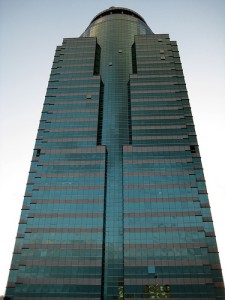Shanzhai Skyscrapers
China is famously a hotbed of copying. Western firms constantly kvetch about Chinese knockoffs of their products—and often with good reason. China’s intellectual property laws are fairly strong, at least on paper. The problem is that the laws aren’t effectively enforced – and it’s an open question whether the Chinese government is capable of shutting down the copyists. China’s uneasy relationship with intellectual-property law is due in no small part to China’s “shanzhai” culture. What is shanzhai? The literal meaning of the word is “mountain stronghold,” but it has come to connote imitation, and more, imitation done in a way that is upfront about its fakery and may even be celebrated for it.
Shanzhai culture is incredibly vibrant and shows no sign of slowing down. Shanzhai cellphones, for instance, are sometimes applauded for their ingenuity. Some include nifty features not seen on the original they are imitating. Some mash-up features found on competing phones into a single device. All are cheap.
There is a lot to say about shanzhai in China, and we’ll come back to this in future posts. But here is a great example. Wired is reporting that a new Beijing building by starchitect Zaha Hadid is being copied even as the original is still under construction:
A Beijing building project by London-based architect Zaha Hadid is proving so popular that the structure is being pirated elsewhere in the country.
Hadid’s Wangjing Soho is an office and retail complex which uses three curved towers to echo the intricate movements of Chinese fans. But, according to Der Spiegel, the architect’s firm is being forced to compete with pirates to get the original structure finished before the copy.
“Even as we build one of Zaha’s projects, it is being replicated in Chongqing,” said Zhang Xin, the property developer who commissioned the structure. “Everyone says that China is a great copycat country, and that it can copy anything.”
Hadid herself seems a little more relaxed about the use of her work, provided the results contain a certain amount of innovation, saying “that could be quite exciting.”
The Hadid building is merely the tip of the iceberg as far as Chinese architectural copying is concerned. China is full of copied buildings, in particular classic Western European designs. In fact, a forthcoming book by Bianca Bosker, the senior tech editor at the Huffington Post, is all about this phenomenon: Original Copies: Architectural Mimicry in Contemporary China tells the story of how entire neighborhoods in China are made to resemble, often in amazing detail, small towns in Europe and famous cities such as Venice.
Now of course this is not totally new, nor totally Chinese. One of us lives right near a place called Venice, CA, that was explicitly designed to evoke the great Italian city and its canals. That said, Venice, CA is more a gesture toward Venice, Italy than a copy of it. The California canals (many long paved over) are vaguely reminiscent of those in Venice, and the actual buildings look nothing like Venice. The Chinese examples Bosker discusses, by contrast, are often exacting in their verisimilitude and, moreover, don’t hesitate to mix and match from different eras and places.
In this case, the Chinese developer of the knockoff Hadid building quickly responded to news reports by incorporating the controversy into his marketing materials and, in a sense, owning it. “Never meant to copy—Only want to surpass,” he wrote. As Bosker said to us, this line may sum a specifically Chinese take on copying: it’s all about getting to the best; who’s first is not the point.
Hadid’s own view is also interesting. Her equanimity over being copied is unusual, but it is probably wise. As we argue in our recent book, The Knockoff Economy: How Imitation Sparks Innovation, copies are authentic advertisements: they show — convincingly — that you are an innovator who produces special things. As Bosker told us, “imitation may be the fastest route to ‘iconic.’”


Comments